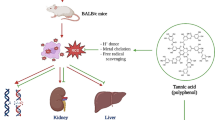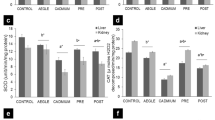Abstract
Aim of this study was to investigate the efficacy of Ginkgo Biloba (G.B) hydro-ethanolic extract against hepatotoxicity induced by combined exposure to cadmium (Cd) and fluoride (F) in Wistar rats. Animals were exposed to F (30 mg/L) + Cd (40 mg/L), F + Cd plus G.B (50,100 and 200 mg/kg), G.B (200 mg/kg), F + Cd plus Vit C(1000 mg/L) in drinking water for 42 days. Significant raise in liver enzymes and histopathological changes were observed in F + Cd treated rats. F + Cd exposure enhanced protein and glutathione oxidation, lipid peroxidation and decreased superoxide dismutase activity. F and Cd combination also caused mitochondrial dysfunction, swelling and mitochondrial membrane potential collapse in liver isolated mitochondria. Up-regulation of inflammatory genes (TNF-α, IL-1β and NF-kB) and pro-apoptotic Bax as well as down-regulation of anti-apoptotic Bcl-2 were detected after co-exposure to F and Cd. Interestingly, G.B alleviated F + Cd induced liver oxidative stress, mitochondrial damage and prevented inflammation and apoptosis. Furthermore, decrease in serum liver enzymes and improvement of histopathologic lesions were observed in G.B treated rats. This study explored the potential beneficial role of G.B on F + Cd combined hepatotoxic effects via considering its possible antioxidant, anti-inflammatory, mitochondrial protection and anti-apoptotic effects.


Similar content being viewed by others
References
Khan R, Ali S, Mumtaz S, Andleeb S, Ulhaq M, Tahir HM, Khan MKA, Khan MA, Shakir HA (2019) Toxicological effects of toxic metals (cadmium and mercury) on blood and the thyroid gland and pharmacological intervention by vitamin C in rabbits. Environ Sci Pollut Res 26(16):16727–16741
Alhusaini AM, Faddah LM, El Orabi NF, Hasan IH (2018) Role of some natural antioxidants in the modulation of some proteins expressions against sodium fluoride-induced renal injury. Biomed Res Int. https://doi.org/10.1155/2018/5614803
Guo Y, Chen L, Wu J, Hua J, Yang L, Wang Q, Zhang W, Lee J-S, Zhou B (2019) Parental co-exposure to bisphenol A and nano-TiO2 causes thyroid endocrine disruption and developmental neurotoxicity in zebrafish offspring. Sci Total Environ 650:557–565
Moghaddam AH, Nabavi SF, Nabavi SM, Loizzo MR, Roohbakhsh A, Setzer WN (2015) Ameliorative effects of curcumin against sodium fluoride-induced hepatotoxicity. Progress Nutr 17(4):324–330
Almeer RS, Alarifi S, Alkahtani S, Ibrahim SR, Ali D, Moneim A (2018) The potential hepatoprotective effect of royal jelly against cadmium chloride-induced hepatotoxicity in mice is mediated by suppression of oxidative stress and upregulation of Nrf2 expression. Biomed Pharmacother 106:1490–1498
Ansari M, Aloliet R, Ganaie M, Khan T, Najeeb-ur-Rehman IF, Hamad AM (2019) Roflumilast, a phosphodiesterase 4 inhibitor, attenuates cadmium-induced renal toxicity via modulation of NF-κB activation and induction of NQO1 in rats. Hum Exp Toxicol 38(5):588–597
Alhusaini A, Faddaa L, Ali HM, Hassan I, El Orabi NF, Bassiouni Y (2018) Amelioration of the protein expression of Cox2, NF κ B, and STAT-3 by some antioxidants in the liver of sodium fluoride-intoxicated rats. Dose-Response 16(3):1559325818800153
Vahidirad M, Arab-Nozari M, Mohammadi H, Shaki F (2018) Protective effect of daravone against nephrotoxicity and neurotoxicity of acute exposure to diazinon. J Mazandaran Univ Med Sci 28(165):175–182
Dai X, Xing C, Cao H, Luo J, Wang T, Liu P, Guo X, Hu G, Zhang C (2018) Alterations of mitochondrial antioxidant indexes and apoptosis in duck livers caused by molybdenum or/and cadmium. Chemosphere 193:574–580
Ye J, Ye C, Huang Y, Zhang N, Zhang X, Xiao M (2019) Ginkgo biloba sarcotesta polysaccharide inhibits inflammatory responses through suppressing both NF-κB and MAPK signaling pathway. J Sci Food Agric 99(5):2329–2339
Elkhadragy MF, Kassab RB, Metwally D, Almeer RS, Abdel-Gaber R, Al-Olayan EM, Essawy EA, Amin HK, Abdel Moneim AE (2018) Protective effects of Fragaria ananassa methanolic extract in a rat model of cadmium chloride-induced neurotoxicity. Bioscience Rep. https://doi.org/10.1042/bsr20180861
Nkpaa KW, Onyeso GI (2018) Rutin attenuates neurobehavioral deficits, oxidative stress, neuro-inflammation and apoptosis in fluoride treated rats. Neurosci Lett 682:92–99
El-Maksoud EMA, Lebda MA, Hashem AE, Taha NM, Kamel MA (2019) Ginkgo biloba mitigates silver nanoparticles-induced hepatotoxicity in Wistar rats via improvement of mitochondrial biogenesis and antioxidant status. Environ Sci Pollut Res 26(25):25844–25854
Mei N, Guo X, Ren Z, Kobayashi D, Wada K, Guo L (2017) Review of Ginkgo biloba-induced toxicity, from experimental studies to human case reports. J Environ Sci Health C Environ Carcinog Ecotoxicol Rev 35(1):1–28
Aydin D, Peker EG, Karakurt MD, Gurel A, Ayyildiz M, Cevher ŞC, Agar E, Dane S (2016) Effects of Ginkgo biloba extract on brain oxidative condition after cisplatin exposure. Clin Invest Med 39(6):27511
Abdel-Zaher AO, Farghaly HS, El-Refaiy AE, Abd-Eldayem AM (2018) Protective effect of the standardized leaf extract of G inkgo biloba (EGb761) against hypertension-induced renal injury in rats. Clin Exp Hypertens 40(8):703–714
Wang Y, Wang R, Wang Y, Peng R, Wu Y, Yuan Y (2015) Ginkgo biloba extract mitigates liver fibrosis and apoptosis by regulating p38 MAPK, NF-κB/IκBα, and Bcl-2/Bax signaling. Drug des, dev Ther 9:6303
Arab-Nozari M, Mohammadi E, Shokrzadeh M, Ahangar N, Amiri FT, Shaki F (2020) Co-exposure to non-toxic levels of cadmium and fluoride induces hepatotoxicity in rats via triggering mitochondrial oxidative damage, apoptosis, and NF-kB pathways. Environ Sci Pollution Res 27(19):24048–24058
Eşrefogˇlu M, Gül M, Dogˇru MI, Dogˇru A, Yürekli M (2007) Adrenomedullin fails to reduce cadmium-induced oxidative damage in rat liver. Exp Toxicol Pathol 58(5):367–374
Messaoudi I, El Heni J, Hammouda F, Saïd K, Kerkeni A (2009) Protective effects of selenium, zinc, or their combination on cadmium-induced oxidative stress in rat kidney. Biol Trace Elem Res 130(2):152–161
Bharti VK, Srivastava R, Kumar H, Bag S, Majumdar A, Singh G, Pandi-Perumal S, Brown GM (2014) Effects of melatonin and epiphyseal proteins on fluoride-induced adverse changes in antioxidant status of heart, liver, and kidney of rats. Adv Pharmacol Sci. https://doi.org/10.1155/2014/532969
Ekambaram P, Namitha T, Bhuvaneswari S, Aruljothi S, Vasanth D, Saravanakumar M (2010) Therapeutic efficacy of Tamarindus indica (L) to protect against fluoride-induced oxidative stress in the liver of female rats. Fluoride 43(2):134
Bradford MM (1976) A rapid and sensitive method for the quantitation of microgram quantities of protein utilizing the principle of protein-dye binding. Anal Biochem 72(1–2):248–254
Habibi E, Arab-Nozari M, Elahi P, Ghasemi M, Shaki F (2018) Modulatory effects of Viola odorata flower and leaf extracts upon oxidative stress-related damage in an experimental model of ethanol-induced hepatotoxicity. Appl Physiol Nutr Metab 44(5):521–527
Ellman M (1959) A spectrophotometric method for determination of reduced glutathione in tissues. Analyt Biochem 74:214–226
Zhang F, Xu Z, Gao J, Xu B, Deng Y (2008) In vitro effect of manganese chloride exposure on energy metabolism and oxidative damage of mitochondria isolated from rat brain. Environ Toxicol Pharmacol 26(2):232–236
Aebi H (1984) [13] Catalase in vitro. In: Packer L (ed) Methods in enzymology. Elsevier, London, pp 121–126
Shokrzadeh M, Zamani E, Mehrzad M, Norian Y, Shaki F (2015) Protective effects of propofol against methamphetamine-induced neurotoxicity. Toxicol Int 22(1):92
Arab-Nozari M, Zamani E, Latifi A, Shaki F (2019) Mitochondrial toxicity of aluminium nanoparticles in comparison to its ionic form on isolated rat brain mitochondria. Bratisl Lek Listy 120(7):516–522
Hosseini M-J, Shaki F, Ghazi-Khansari M, Pourahmad J (2013) Toxicity of arsenic (III) on isolated liver mitochondria: a new mechanistic approach. Iranian J pharm Res 12(Suppl):121
Kaur S, Sharma N, Nehru B (2018) Anti-inflammatory effects of Ginkgo biloba extract against trimethyltin-induced hippocampal neuronal injury. Inflammopharmacology 26(1):87–104
Chen L, Qu G, Sun X, Zhang S, Wang L, Sang N, Du Y, Liu J, Liu S (2013) Characterization of the interaction between cadmium and chlorpyrifos with integrative techniques in incurring synergistic hepatoxicity. PLoS ONE 8(3):e59553
Sudhakar K, Nageshwar M, Reddy P (2017) Seed extract of Abelmoschus moschatus medik reverses NaF-induced behavioral changes through neurodegeneration and oxidative stress in brain of rat. Asian J Pharm Clin Res 10(10):165–171
Saleh AS (2019) Evaluation of hepatorenal protective activity of Moringa oleifera on histological and biochemical parameters in cadmium intoxicated rats. Toxin Rev 38(4):338–345
Mitta R, Kandula RR, Pulala RY, Korlakunta NJ (2018) Alleviatory effects of hydroalcoholic extract of Brassica oleracea var botrytis leaves against sodium fluoride induced hepatotoxicity and oxidative stress on male Wistar rats. Indian J biochem Bio 55(3):191–197
Badore NS, Das PK, Pillai S, Thakur A (2017) Role of Ginkgo biloba extract, against isoproterenol induced cardiac toxicity in rats. Indian J Pharm Educ 51(4):S691–S699
Chandel NS (2015) Evolution of mitochondria as signaling organelles. Cell Metab 22(2):204–206
Gogvadze V, Orrenius S, Zhivotovsky B (2006) Multiple pathways of cytochrome c release from mitochondria in apoptosis. Biochim et Biophys Acta 1757(5–6):639–647
Wei Q, Luo Q, Liu H, Chen L, Cui H, Fang J, Zuo Z, Deng J, Li Y, Wang X (2018) The mitochondrial pathway is involved in sodium fluoride (NaF)-induced renal apoptosis in mice. Toxicology research 7(5):792–808
Pan Y-X, Luo Z, Zhuo M-Q, Wei C-C, Chen G-H, Song Y-F (2018) Oxidative stress and mitochondrial dysfunction mediated Cd-induced hepatic lipid accumulation in zebrafish Danio rerio. Aquat Toxicol 199:12–20
Saini AS, Taliyan R, Sharma PL (2014) Protective effect and mechanism of Ginkgo biloba extract-EGb 761 on STZ-induced diabetic cardiomyopathy in rats. Pharmacognosy magazine 10(38):172
Mahdavi S, Khodarahmi P, Roodbari N (2018) Effects of cadmium on Bcl-2/Bax expression ratio in rat cortex brain and hippocampus. Hum Exp Toxicol 37(3):321–328
Ahmed MM, El-Shazly SA, Alkafafy ME, Mohamed AA, Mousa AA (2018) Protective potential of royal jelly against cadmium-induced infertility in male rats. Andrologia 50(5):e12996
Lee J, Lim KT (2011) Preventive effect of phytoglycoprotein (27 kDa) on inflammatory factors at liver injury in cadmium chloride-exposed ICR mice. J Cell Biochem 112(2):694–703
Piazza S, Pacchetti B, Fumagalli M, Bonacina F, Dell’Agli M, Sangiovanni E (2019) Comparison of two ginkgo biloba L. extracts on oxidative stress and inflammation markers in human endothelial cells. Mediators Inflamm. https://doi.org/10.1155/2019/6173893
Song Y, Zhang R, Wang H, Yan Y, Ming G (2018) Protective effect of Agaricus blazei polysaccharide against cadmium-induced damage on the testis of chicken. Biol Trace Elem Res 184(2):491–500
Oliveira D, Latimer C, Parpot P, Gill CI, Oliveira R (2019) Antioxidant and antigenotoxic activities of Ginkgo biloba L leaf extract are retained after in vitro gastrointestinal digestive conditions. Eur J Nutr 59(2):465–476
Verma S, Ranawat P, Sharma N, Nehru B (2019) Ginkgo biloba attenuates aluminum lactate-induced neurotoxicity in reproductive senescent female rats: behavioral, biochemical, and histopathological study. Environ Sci Pollut Res 26(26):27148–27167
Owumi SE, Ochaoga SE, Odunola OA, Farombi EO (2019) Protocatechuic acid inhibits testicular and epididymal toxicity associated with methotrexate in rats. J Andrologia. https://doi.org/10.1111/and.13350
Kim M, Yoo G, Randy A, Kim HS, Nho CW (2017) Chicoric acid attenuate a nonalcoholic steatohepatitis by inhibiting key regulators of lipid metabolism, fibrosis, oxidation, and inflammation in mice with methionine and choline deficiency. Mol Nutr Food Res 61(5):1600632
Caglayan C, Kandemir FM, Darendelioğlu E, Yıldırım S, Kucukler S, Dortbudak MB (2019) Rutin ameliorates mercuric chloride-induced hepatotoxicity in rats via interfering with oxidative stress, inflammation and apoptosis. J Trace Elem Med Biol 56:60–68
Calixto-Campos C, Carvalho TT, Hohmann MS, Pinho-Ribeiro FA, Fattori V, Manchope MF, Zarpelon AC, Baracat MM, Georgetti SR, Casagrande R (2015) Vanillic acid inhibits inflammatory pain by inhibiting neutrophil recruitment, oxidative stress, cytokine production, and NFκB activation in mice. J Nat Prod 78(8):1799–1808
Meng J, Zhang C (2019) Modulating Effects of Vanillic Acid on Sepsis-induced Oxidative Liver Injury in Rat Model. Pharmacology 15(6):752–758
Acknowledgements
This study was extracted from PhD thesis of Milad Arab-Nozari and supported by a grant from the Research Council of Mazandaran University of Medical Sciences, Sari, Iran [Grant Number: 1484].
Author information
Authors and Affiliations
Corresponding author
Ethics declarations
Conflict of interest
The authors declare that they have no conflict of interest.
Research involving Human and Animal Participants
This research was involved animals and was performed according to ethical protocols approved by the Committee of Animal Experimentation of Mazandaran University of Medical Sciences, Sari, Iran.
Additional information
Publisher's Note
Springer Nature remains neutral with regard to jurisdictional claims in published maps and institutional affiliations.
Rights and permissions
About this article
Cite this article
Arab-Nozari, M., Ahangar, N., Mohammadi, E. et al. Ginkgo biloba attenuated hepatotoxicity induced by combined exposure to cadmium and fluoride via modulating the redox imbalance, Bax/Bcl-2 and NF-kB signaling pathways in male rats. Mol Biol Rep 47, 6961–6972 (2020). https://doi.org/10.1007/s11033-020-05755-2
Received:
Accepted:
Published:
Issue Date:
DOI: https://doi.org/10.1007/s11033-020-05755-2




